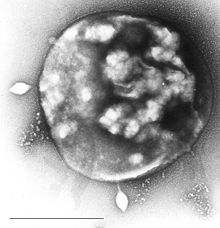Proposed kingdom of archaea
Proteoarchaeota is a proposed archaeal kingdom thought to be closely related and possibly ancestral to the Eukaryotes .[ 2] [ 3] [ a]
Classification
The phylogenetic relationship of this group is still under discussion. The relationship of the members is approximately as follows:[ 4] [ 5] [ 6] [ 7]
Notes
^ Approximately the same group is sometimes referred to as TACK after the initial letters of its early-found daughter clades: Thaumarchaeota (now Nitrososphaerota ), "Aigarchaeota ", Crenarchaeota (now Thermoproteota ), and "Korarchaeota ". Because of the unsettled phylogeny of the group, the names "Proteoarchaeota" and TACK may become distinct after further re-organization. (Indeed, the addition of the Asgard group has made the two entities distinct.)
References
^ Castelle, C.J.; Banfield, J.F. (2018). "Major New Microbial Groups Expand Diversity and Alter our Understanding of the Tree of Life" . Cell . 172 (6): 1181– 1197. doi :10.1016/j.cell.2018.02.016 PMID 29522741 . ^ Petitjean, C.; Deschamps, P.; López-García, P.; Moreira, D. (2014). "Rooting the domain Archaea by phylogenomic analysis supports the foundation of the new kingdom Proteoarchaeota" . Genome Biol. Evol . 7 (1): 191– 204. doi :10.1093/gbe/evu274 . PMC 4316627 PMID 25527841 . ^ Eugene V. Koonin (2015). "Archaeal ancestors of Eukaryotes: Not so elusive any more" . BMC Biology . 13 (1): 84. doi :10.1186/s12915-015-0194-5 PMC 4594999 PMID 26437773 . ^ Spang, Anja; Saw, Jimmy H.; Jørgensen, Steffen L.; Zaremba-Niedzwiedzka, Katarzyna; Martijn, Joran; Lind, Anders E.; van Eijk, Roel; Schleper, Christa; Guy, Lionel; Ettema, Thijs J.G. (2015). "Complex archaea that bridge the gap between prokaryotes and eukaryotes" . Nature . 521 (7551): 173– 179. Bibcode :2015Natur.521..173S . doi :10.1038/nature14447 . PMC 4444528 PMID 25945739 . ^ Zaremba-Niedzwiedzka, Katarzyna; Caceres, Eva F.; Saw, Jimmy H.; Bäckström, Disa; Juzokaite, Lina; Vancaester, Emmelien; Seitz, Kiley W.; Anantharaman, Karthik; Starnawski, Piotr; Kjeldsen, Kasper U.; Stott, Matthew B.; Nunoura, Takuro; Banfield, Jillian F.; Schramm, Andreas; Baker, Brett J.; Spang, Anja; Ettema, Thijs J.G. (2017). "Asgard archaea illuminate the origin of eukaryotic cellular complexity" . Nature . 541 (7637): 353– 358. Bibcode :2017Natur.541..353Z . doi :10.1038/nature21031 . OSTI 1580084 . PMID 28077874 . S2CID 4458094 . ^ Zaremba-Niedzwiedzka, Katarzyna; et al. (19 January 2017). "Asgard archaea illuminate the origin of eukaryotic cellular complexity" . Nature . 541 (7637): 353– 358. Bibcode :2017Natur.541..353Z . doi :10.1038/nature21031 . OSTI 1580084 . PMID 28077874 . S2CID 4458094 . ^ Fournier, Gregory P.; Poole, Anthony M. (2018). "A briefly argued case that Asgard Archaea are part of the Eukaryote tree" . Frontiers in Microbiology . 9 : 1896. doi :10.3389/fmicb.2018.01896 ISSN 1664-302X . PMC 6104171 PMID 30158917 .
